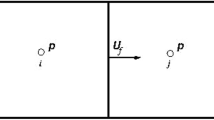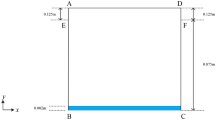Abstract
In this study, an effective collocation method using new weighted orthogonal basis functions on the half-line, namely the exponential Bernstein functions, is proposed for simulating the solution of the heat transfer of a micropolar fluid through a porous medium with radiation. The governing equations and their associated boundary conditions can be written as a system of nonlinear ordinary differential equations. The presented approach does not require truncating or transforming the semi-infinite domain of the problem to a finite domain. In addition, this method reduces the solution of the problem to the solution of a system of algebraic equations. The effects of the coupling constant, radiation parameter and the permeability parameter on velocity and temperature profiles will be discussed in detail and shown graphically. A comparative study with the previous results of viscous fluid in the literature is made.


















Similar content being viewed by others
Abbreviations
- \(B_{i,n}(x)\) :
-
Bernstein polynomial of degree n
- \(\mathfrak {B}_{i,n}(x)\) :
-
Orthogonal Bernstein polynomial of order n
- \(\varvec{EB}_{i,n}(x;L)\) :
-
Exponential Bernstein function of order n
- \(c_p\) :
-
Specific heat
- f :
-
Dimensionless velocity function
- \(G_1\) :
-
Microrotation constant
- g :
-
Dimensionless microrotation angular velocity
- K :
-
Permeability of the porous medium
- \(k^{*}\) :
-
Mean absorption coefficient
- \(k_1\) :
-
Coupling constant
- L :
-
Positive scaling/stretching factor
- \(q_r\) :
-
Radiant heat flux
- S :
-
Constant characteristic to the fluid
- T :
-
Temperature distribution
- \(U_0\) :
-
Uniform stream velocity
- u :
-
Velocity component in the x direction
- v :
-
Velocity component in the y direction
- x :
-
Horizontal coordinate
- y :
-
Vertical coordinate
- Pr :
-
Prandtl number
- \(\rho \) :
-
Fluid density
- \(\mu \) :
-
Dynamical viscosity
- \(\nu \) :
-
Kinematic viscosity
- \(\sigma \) :
-
Angular velocity
- \(\eta \) :
-
Similarity variable
- \(\sigma ^{*}\) :
-
Stefan–Boltzmann constant
- \(\theta \) :
-
Dimensionless temperature
- \(\varphi \) :
-
Porosity
- w :
-
Conditions at the surface
- \(\infty \) :
-
Conditions far away from the surface
- n :
-
Order of approximation
- \(^\prime \) :
-
Differentiation with respect to \(\eta \)
References
Abo-Eldahab EM, El Aziz MA (2005) Flow and heat transfer in a micropolar fluid past a stretching surface embedded in a non-Darcian porous medium with uniform free stream. Appl Math Comput 162:881–899
Abo-Eldahab EM, Ghonaim AF (2005) Radiation effect on heat transfer of a micropolar fluid through a porous medium. Appl Math Comput 169:500–510
Adomian G (1994) Solving frontier problems of physics: the decomposition method. Kluwer Academic Publishers, Dordrecht
Ahmadi G (1976) Self-similar solution of incompressible micropolar boundary layer flow over a semi-infinite plate. Int J Eng Sci 14:639–646
Ariman T, Turk MA, Sylvester ND (1973) Microcontinuum fluid mechanics-areview. Int J Eng Sci 11:905–930
Bhatta DD, Bhatti MI (2006) Numerical solution of KdV equation using modified Bernstein polynomials. Appl Math Comput 174:1255–1268
Bhattacharya S, Mandal BN (2008) Use of Bernstein polynomials in numerical solutions of Volterra integral equations. Appl Math Sci 2:1773–1787
Bhatti MI, Bracken P (2007) Solutions of differential equations in a Bernstein polynomial basis. J Comput Appl Math 205:272–280
Boyd JP (1982) The optimization of convergence for Chebyshev polynomial methods in an unbounded domain. J Comput Phys 45:43–79
Boyd JP (2001) Chebyshev and Fourier spectral methods, 2nd edn. Dover Publications Inc., Mineola
Chakrabarti A, Martha SC (2009) Approximate solutions of Fredholm integral equations of the second kind. Appl Math Comput 211:459–466
Civalek O (2007) Nonlinear analysis of thin rectangular plates on Winkler-Pasternak elastic foundations by DSC-HDQ methods. Appl Math Model 31:606–624
Doha EH, Bhrawy AH, Saker MA (2011a) On the derivatives of bernstein polynomials: an application for the solution of high even-order differential equations. Bound Value Probl 2011:1–16, Art. ID 829543
Doha EH, Bhrawy AH, Saker MA (2011b) Integrals of Bernstein polynomials: an application for the solution of high even-order differential equations. Appl Math Lett 24:559–565
Dormand JR, Prince PJ (1980) A family of embedded Runge–Kutta formulae. J Comput Appl Math 6:19–26
Eringen AC (1964) Simple microfluids. Int J Eng Sci 2:205–217
Eringen AC (1966) Theory of micropolar fluids. J Math Mech 16:1–18
Eringen AC (1972) Theory of termomicrofluids. J Math Anal Appl 38:480–496
Farouki RT, Goodman TNT (1996) On the optimal stability of Bernstein basis. Math Comput 65:1553–1566
Ganji SS, Ganji DD, Sfahani MG, Karimpour S (2010) Application of AFF and HPM to the systems of strongly nonlinear oscillation. Curr Appl Phys 10:1317–1325
Ganji SS, Ganji DD, Davodi AG, Karimpour S (2010) Analytical solution to nonlinear oscillation system of the motion of a rigid rod rocking back using max-min approach. Appl Math Modell 34:2676–2684
Ganji SS, Barari A, Ganji DD (2011) Approximate analyses of two mass-spring systems and buckling of a column. Comput Math Appl 61:1088–1095
Gorla RSR (1992) Mixed convection in a micropolar fluid from a vertical surface with uniform heat flux. Int J Eng Sci 30:349–358
He JH (1999) Variational iteration method—a kind of non-linear analytical technique: some examples. Int J Nonlinear Mech 34:699–708
He JH (2000) Variational iteration method for autonomous ordinary differential systems. Appl Math Comput 114:115–123
He JH (2003) Homotopy perturbation method: a new nonlinear analytical technique. Appl Math Comput 135:73–79
He JH (2004) The homotopy perturbation method for nonlinear oscillators with discontinuities. Appl Math Comput 151:287–292
He JH (2006) Exp-function method for nonlinear wave equations. Chaos, Solitons Fractals 30:700–708
He JH, Abdou MA (2007) New periodic solutions for nonlinear evolution equations using Exp-function method. Chaos, Solitons Fractals 34:1421–1429
Ibrahim FS, Hassanien IA, Bakr AA (2004) Unsteady magnetohydrodynamic micropolar fluid flow and heat transfer over a vertical porous plate through a porous medium in the presence of thermal and mass diffusion with a constant heat source. Can J Phys 82:775–790
Karmishin AV, Zhukov AI, Kolosov VG (1990) Methods of dynamics calculation and testing for thin-walled structures. Mashinostroyenie, Moscow
Kim YJ (2001) Unsteady convection flow of micropolar fluids past a vertical plate embedded in a porous medium. Acta Mech 148:105–116
Kim YJ (2004) Heat and mass transfer in MHD micropolar flow over a vertical moving plate in a porous medium. Trans Porous Media 56:17–37
Kreyszig E (1978) Introductory functional analysis with applications. Wiley, New York
Liao SJ (2003) Beyond perturbation: introduction to the homotopy analysis method. Hall/CRCPress, Boca Raton
Maleknejad K, Hashemizadeh E, Ezzati R (2011) A new approach to the numerical solution of Volterra integral equations by using Bernstein’s approximation. Commun Nonlinear Sci Numer Simulat 16:647–655
Maleknejad K, Hashemizadeh E, Basirat B (2012) Computational method based on Bernstein operational matrices for nonlinear Volterra-Fredholm-Hammerstein integral equations. Commun Nonlinear Sci Numer Simulat 17:52–61
Mandal BN, Bhattacharya S (2007) Numerical solution of some classes of integral equations using Bernstein polynomials. Appl Math Comput 190:1707–1716
Nield DA, Bejan A (2006) Convection in porous media. Springer, New York
Raptis A (1998) Flow of a micropolar fluid past a continuously moving plate by the presence of radiation. Int J Heat Mass Transf 41:2865–2866
Raptis A, Perdikis C, Takhar HS (2004) Effect of thermal radiation on MHD flow. Appl Math Comput 153:645–649
Rashidi MM, Mohimanian pour SA, Abbasbandy S (2011) Analytic approximate solutions for heat transfer of a micropolar fluid through a porous medium with radiation. Commun Nonlinear Sci Numer Simulat 16:1874–1889
Rashidi MM, Mohimanian Pour SA (2010) A novel analytical solution of heat transfer of a micropolar fluid through a porous medium with radiation by DTM-Padé. Heat Trans Asian Res 39:575–589
Ravi ASV, Kanth YN, Reddy A (2003) numerical method for solving two-point boundary value problems over infinite intervals. Appl Math Comput 144:483–494
Rees DAS, Pop I (1998) Free convection boundary layer flow of micropolar fluid from a vertical flat Plat. IMA J Appl Math 61:179–197
Rostamy D, Karimi K (2012) Bernstein polynomials for solving fractional heat- and wave-like equations. Fract Calc Appl Anal 15:556–571
Shahzad F, Sajid M, Hayat T, Ayub M (2007) Analytic solution for flow of a micropolar fluid. Acta Mech 188:93–102
Singh AK (2002) Numerical solution of unsteady free convection flow of an incompressible micropolar fluid past an infinite vertical plate with temperature gradient dependent heat source. J Energy Heat Mass Transf 24:185–194
Singh AK, Singh VK, Singh OP (2009) The Bernstein operational matrix of integration. Appl Math Sci 3:2427–2436
Snyder MA (1966) Chebyshev methods in numerical approximation. Prentice-Hall Inc., Englewood Cliffs
Soundalgekar VM, Takhar HS (1983) Flow of a micropolar fluid on a continuous moving plate. Int J Eng Sci 21:961–965
Wang M, Li X (2005) Applications of F-expansion to periodic wave solutions fo a new Hamiltonian amplitude equation. Chaos, Solitons Fractals 24:1257–1268
Xu H, Liao SJ, Pop I (2006) Series solutions of unsteady boundary layer flow of a micropolar fluid near the forward stagnation point of a plane surface. Acta Mech 184:87–101
Yousefi SA, Behroozifar M, Dehghan M (2011) The operational matrices of Bernstein polynomials for solving the parabolic equation subject to specification of the mass. J Comput Appl Math 235:5272–5283
Yousefi SA, Behroozifar M, Dehghan M (2012) Numerical solution of the nonlinear age-structured population models by using the operational matrices of Bernstein polynomials. Appl Math Model 36:945–963
Yousefi SA, Behroozifar M (2010) Operational matrices of Bernstein polynomials and their applications. Int J Syst Sci 41:709–716
Author information
Authors and Affiliations
Corresponding author
Additional information
Communicated by Philippe Devloo.
Appendix A: Basic idea of Liaos Homotopy analysis method (HAM) (Liao 2003)
Appendix A: Basic idea of Liaos Homotopy analysis method (HAM) (Liao 2003)
Consider the following nonlinear differential equation in form of
where N is a nonlinear operator, t is an independent variable and \(u\left( t\right) \) is the solution of equation. By means of generalizing the conventional Homotopy method, Liao constructed the so-called zero-order deformation equation as:
where \(q\in \left[ 0,1\right] \) is an embedding parameter, \(h\ne 0\) is a nonzero auxiliary parameter, \(H\left( t\right) \ne 0\) is an auxiliary function, L is an auxiliary linear operator with the property
\(u_{0}(t) \) is an initial guess of u( t) and \(\Phi \left( t;q\right) \) is an unknown function on the independent variables t and q. Obviously, when \(q=0\) and \(q=1\), it holds
respectively. Thus, as q increases from 0 to 1, the solution \(\Phi ( t;q) \) varies from the initial guess \(u_{0}(t)\) to the solution u(t) . Using the parameter q , we expand \(\Phi \left( t;q\right) \) in Taylor series as follows:
where
Assume that auxiliary linear operator, the initial guess, the controlling convergence parameter h , and the auxiliary function H(t) are chosen such that the series (100) converges at \(q=1\). So, from (99) and (100), we have
Define the vector
Differentiating (97) for m times with respect to the embedding parameter q and then setting \(q=0\) and finally dividing them by m! , we have the so-called mth-order deformation equation
where
and
Applying \(L^{-1}\) on both sides of (103), we get
In this way, it is easy to obtain \(u_m\) for \(m\ge 1\), at Mth order; we have
When \(M\rightarrow +\infty \), we get an accurate approximation of the original Eq. (96). For the convergence of the previous method, we refer the reader to Liao (2003). Rashidi and Mohimanian Pour (2011) implemented the above method for solving heat transfer problem of a micropolar fluid through a porous medium with radiation.
Rights and permissions
About this article
Cite this article
Heydari, M., Loghmani, G.B. & Hosseini, S.M. Exponential Bernstein functions: an effective tool for the solution of heat transfer of a micropolar fluid through a porous medium with radiation. Comp. Appl. Math. 36, 647–675 (2017). https://doi.org/10.1007/s40314-015-0251-2
Received:
Revised:
Accepted:
Published:
Issue Date:
DOI: https://doi.org/10.1007/s40314-015-0251-2
Keywords
- Micropolar fluid
- Porous medium
- Bernstein polynomials
- Exponential Bernstein functions (EBFs)
- Collocation method
- Semi-infinite interval




